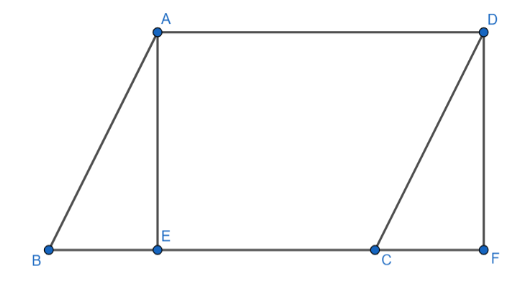
How do you find the area of parallelogram with 2 sides and angle?
Answer
550.2k+ views
Hint: The formula for the area of a parallelogram is $ ab\sin \theta $ where a and b are length of 2 consecutive sides of the parallelogram. We can find the area of the parallelogram using this formula.
Complete step by step answer:
Let’s draw the figure of a parallelogram

In the above figure, ABCD is a parallelogram and AE is the height of the parallelogram. DF is the height drawn from D.
Length of AE = length DF
And angle ABE = angle DCF
So triangle ABE and triangle DCF are congruent
So the area of ABE= area of DCF
Area of parallelogram ABCD = area of triangle ABE + area of trapezium AECD
We can replace ABE with the area of DCF in the above equation.
Area of parallelogram ABCD= area of triangle DCF + area of trapezium AECD
We can see in the figure area of triangle DCF + area of trapezium AECD is equal to the area of rectangle AEFD
We can write
Area of parallelogram ABCD = area of rectangle AEFD
We know that area of rectangle = length $ \times $ breath
So area of rectangle AEFD= $ EF\times AE $
$ \Rightarrow EF=EC+CF $
CF is equal to BE from congruence of ABE and ACF
$ \Rightarrow EF=EC+BE $
$ \Rightarrow EF=BC $
Area of AEFD= $ BC\times AE $
Area of parallelogram ABCD= $ BC\times AE $
In triangle ABE, $ AE=AB\times \sin B $
Area of parallelogram ABCD= $ AB\times BC\times \sin B $
$ \sin B=\sin A $ in ABCD as $ A+B={{180}^{\circ }} $
AB and BC are consecutive side of ABCD
So if 2 sides and one angle is given parallelogram the area will be product of 2 sides and sin of given angle.
Note:
If the vector form of 2 consecutive sides are given in a parallelogram then the area of parallelogram is $ \left| \overrightarrow{a}\times \overrightarrow{b} \right| $ where $ \overrightarrow{a} $ and $ \overrightarrow{b} $ are given vectors of sides. If all sides are same in a parallelogram it will became a rhombus area of rhombus is $ \dfrac{1}{2}\times $ product of diagonals.
Complete step by step answer:
Let’s draw the figure of a parallelogram

In the above figure, ABCD is a parallelogram and AE is the height of the parallelogram. DF is the height drawn from D.
Length of AE = length DF
And angle ABE = angle DCF
So triangle ABE and triangle DCF are congruent
So the area of ABE= area of DCF
Area of parallelogram ABCD = area of triangle ABE + area of trapezium AECD
We can replace ABE with the area of DCF in the above equation.
Area of parallelogram ABCD= area of triangle DCF + area of trapezium AECD
We can see in the figure area of triangle DCF + area of trapezium AECD is equal to the area of rectangle AEFD
We can write
Area of parallelogram ABCD = area of rectangle AEFD
We know that area of rectangle = length $ \times $ breath
So area of rectangle AEFD= $ EF\times AE $
$ \Rightarrow EF=EC+CF $
CF is equal to BE from congruence of ABE and ACF
$ \Rightarrow EF=EC+BE $
$ \Rightarrow EF=BC $
Area of AEFD= $ BC\times AE $
Area of parallelogram ABCD= $ BC\times AE $
In triangle ABE, $ AE=AB\times \sin B $
Area of parallelogram ABCD= $ AB\times BC\times \sin B $
$ \sin B=\sin A $ in ABCD as $ A+B={{180}^{\circ }} $
AB and BC are consecutive side of ABCD
So if 2 sides and one angle is given parallelogram the area will be product of 2 sides and sin of given angle.
Note:
If the vector form of 2 consecutive sides are given in a parallelogram then the area of parallelogram is $ \left| \overrightarrow{a}\times \overrightarrow{b} \right| $ where $ \overrightarrow{a} $ and $ \overrightarrow{b} $ are given vectors of sides. If all sides are same in a parallelogram it will became a rhombus area of rhombus is $ \dfrac{1}{2}\times $ product of diagonals.
Recently Updated Pages
Master Class 10 General Knowledge: Engaging Questions & Answers for Success

Master Class 10 Computer Science: Engaging Questions & Answers for Success

Master Class 10 English: Engaging Questions & Answers for Success

Master Class 10 Social Science: Engaging Questions & Answers for Success

Master Class 10 Maths: Engaging Questions & Answers for Success

Master Class 10 Science: Engaging Questions & Answers for Success

Trending doubts
The shortest day of the year in India

Why is there a time difference of about 5 hours between class 10 social science CBSE

Write a letter to the principal requesting him to grant class 10 english CBSE

What is the median of the first 10 natural numbers class 10 maths CBSE

The Equation xxx + 2 is Satisfied when x is Equal to Class 10 Maths

State and prove converse of BPT Basic Proportionality class 10 maths CBSE




